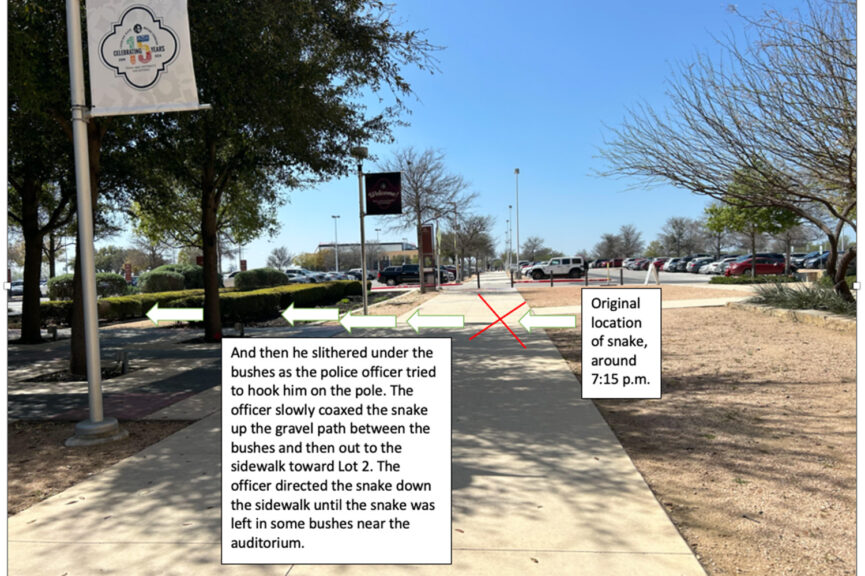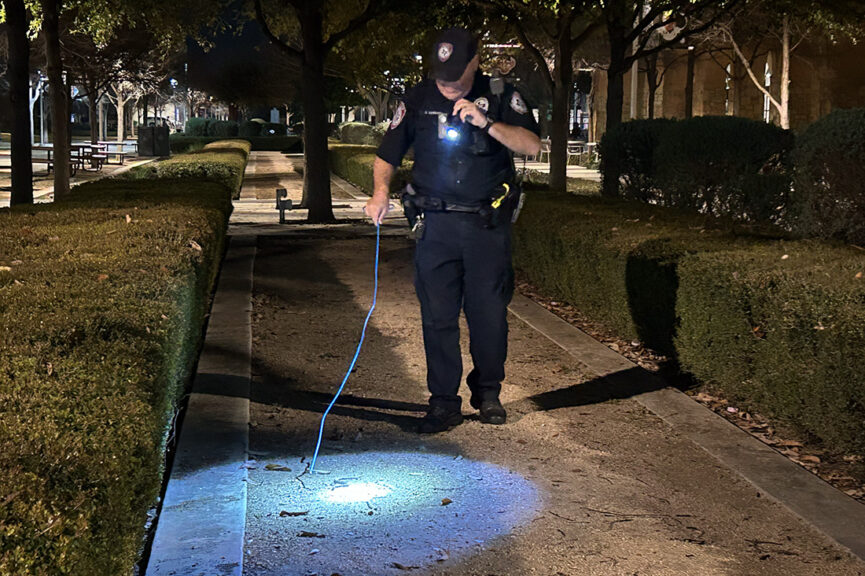A campus police officer wrangled a rattlesnake Monday night at Texas A&M University-San Antonio between the Science and Technology Building and Auditorium.
Officer Daniel Stoddard with the University Police Department responded to a 7:18 p.m. call about a snake sighting on a main walkway. He used a pole to move the snake to some bushes next to the Auditorium.
A campus expert, who identified the snake as a Western diamondback rattlesnake, said students, staff and faculty will see more snakes as temperatures rise and construction continues to displace wildlife.
“We have things for them to eat here, but chances are — because we have all the construction — all those animals that used to live there have to go somewhere,” said Dr. Charles Watson, associate professor of biology. “And we’ll probably see a number of animals passing through as they flee the construction.”
Watson, a herpetologist, who grew up in the forests of East Texas has always been interested in anything biological.

“The reason I work with reptiles and amphibians is because the kind of questions that my lab likes to ask and the kind of things we investigate in most cases are reptiles, especially lizards are the best group of organisms to use in pursuing those questions,” Watson said.
Western diamondback rattlesnakes primarily eat rodents, pack a venomous bite and have a rattle at the end of their tail to warn others that they are present.
Watson said this is probably one of the more dangerous snakes in the area, but if people just leave them alone, there is zero chance they will get bitten.
“They usually account for a few bites in Texas every year,” Watson said. “Deaths by snake bite is crazy uncommon… and that’s in the U.S.”
Teresa Talerico, clinical assistant professor of communication, spotted the snake on campus as she was walking to Lot 2. She said the reptile was on the main walkway — not moving — adjacent to the Science and Technology Building.
Talerico described a small crowd that gathered at a safe distance: students warned passers-by to avoid getting close to the snake, and a few people, including education junior Audrey Olson, took photos and videos. One man wondered if it was a garter snake.
Meanwhile, the snake coiled itself and then began moving across the pavement.
Video courtesy of Teresa Talerico.
When a student seemed convinced it was a rattler, Talerico called UPD’s nonemergency number at 7:18 p.m.
Stoddard responded in roughly five minutes, Talerico said. By then, the snake had slithered under some bushes between the Science and Technology Building and the Auditorium. Stoddard coaxed it out with a pole and moved it to bushes along the Auditorium’s exterior wall.
Watson, who examined photos of the snake, estimated that it was a yearling, which means it is one-year-old.
He said it is highly likely there are other venomous snakes in the campus area, although he has not seen any.
“Avoid them by staying on well lighted paths and just keep an eye out where you’re walking,” said Watson. “But if you see a snake on campus … contact one of the police officers.”
Those with additional wildlife concerns can reach out to UPD at 210-784-1900.









